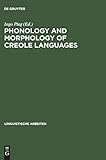Phonology and Morphology of Creole Languages / ed. by Ingo Plag.
Material type: TextSeries: Linguistische Arbeiten ; 478Publisher: Tübingen : Max Niemeyer Verlag, [2014]Copyright date: ©2003Edition: Reprint 2014Description: 1 online resource (376 p.) : Zahlr. AbbContent type:
TextSeries: Linguistische Arbeiten ; 478Publisher: Tübingen : Max Niemeyer Verlag, [2014]Copyright date: ©2003Edition: Reprint 2014Description: 1 online resource (376 p.) : Zahlr. AbbContent type: - 9783484304789
- 9783110929560
- 417/.22 22
- PM7831 .P46 2003
- online - DeGruyter
- Issued also in print.
| Item type | Current library | Call number | URL | Status | Notes | Barcode | |
|---|---|---|---|---|---|---|---|
 eBook
eBook
|
Biblioteca "Angelicum" Pont. Univ. S.Tommaso d'Aquino Nuvola online | online - DeGruyter (Browse shelf(Opens below)) | Online access | Not for loan (Accesso limitato) | Accesso per gli utenti autorizzati / Access for authorized users | (dgr)9783110929560 |
Frontmatter -- Table of Contents -- Preface -- Introduction -- Section 1: Segments and syllables -- Markedness, faithfulness and creolization: The retention of the unmarked -- A new look at nasalization in Haitian Creole -- Two types of R deletion in Haitian Creole -- Rules vs. analogy: Modeling variation in word-final epenthesis in Sranan -- New evidence from the past: To epenthesize or not to epenthesize? That is the question -- Syllabic structure and creolization in Saotomense -- Section 2: Stress, tone and intonation -- The accentual system of Haitian Creole: The role of transfer and markedness values -- African American English suprasegmentals: Α study of pitch patterns in the Black English of the United States -- Section 3: Morphophonology -- The role of tone and rhyme structure in the organisation of grammatical morphemes in Tobagonian -- Prosodic contrast in Jamaican Creole reduplication -- Syllable structure and lexical markedness in Creole morphophonology: Determiner allomorphy in Haitian and elsewhere -- Section 4: Derivational morphology -- Early 18th century Sranan -man -- Morphological processes of word formation in Chabacano (Philippine Spanish Creole) -- The -pela suffix in Tok Pisin and the notion of'simplicity' in pidgin and Creole languages: What happens to morphology under contact? -- Section 5: Inflectional morphology -- What verbal morphology can tell us about Creole genesis: the case of French-related Creoles -- Inflectional plural marking in pidgins and Creoles: A comparative study -- Inflectional categories in Creole languages -- Subject Index -- Language Index -- Author Index
restricted access online access with authorization star
http://purl.org/coar/access_right/c_16ec
Contents: Christian Uffmann, Markedness, faithfulness and creolization: The retention of the unmarked. - Albert Valdman/Iskra Iskrova, A new look at nazalization in Haitian Creole. - Emmanuel Nikiema/Parth Bhatt, Two types of R deletion in Haitian Creole. - Sabine Lappe/Ingo Plag, Rules versus analogy: Modeling variation in word-final epenthesis in Sranan. - Norval Smith, New evidence from the Past: To epenthesize or not to epenthesize, that is the question. - Emmanuel Schang, Syllabic structure and creolization in Saotomense. - Anne-Marie Brousseau, The accentual system of Haitian Creole: The role of transfer and markedness values. - David Sutcliffe, African American English suprasegmentals: A study of pitch patterns in the Black English of the United States. - Winford James, The role of tone and rhyme structure in the organisation of grammatical morphemes in Tobagonian. - Shelome Gooden, Prosodic contrast in Jamaican Creole reduplication. - Thomas Klein, Syllable structure and lexical markedness in creole morphophonology: Determiner allomorphy in Haitian and elsewhere. - Margot van den Berg, Early 18th century Sranan -man. - Patrick Steinkrüger, Morphological processes of word formation in Chabacano (Philippine Spanish Creole). - Nicholas Faraclas, The -pela suffix in Tok Pisin and the notion of ›simplicityTonjes Veenstra, What verbal morphology can tell us about creole genesis: the case of French-related creoles. - Marlyse Baptista, Inflectional plural marking in pidgins and creoles: a comparative study. - Alain Kihm, Inflectional categories in creole languages.
Until very recently, phonology and morphology have been neglected areas in the study of creole languages. This collection of articles presents intriguing data and new analyses from a wide range of creoles that call into question traditional claims about the nature of the phonological and morphological systems of these languages and give crucial insights into one of the major questions of creole studies, i.e. the question of how these languages and their grammars come about. The volume is organized into 5 sections, each focusing on particular aspects of the respective subsystems: ›Segments and syllablesStress, tone and intonationMorphophonologyDerivational morphologyInflection‹.
Issued also in print.
Mode of access: Internet via World Wide Web.
In English.
Description based on online resource; title from PDF title page (publisher's Web site, viewed 28. Feb 2023)


